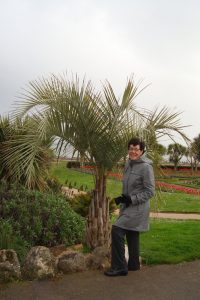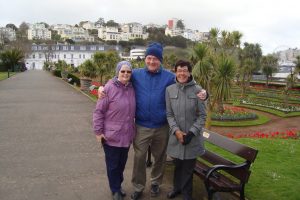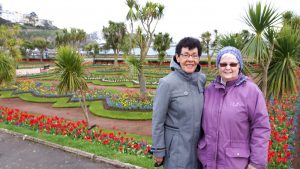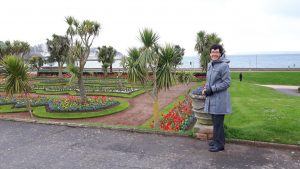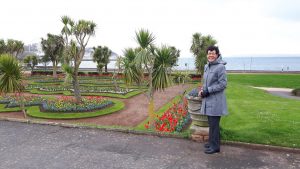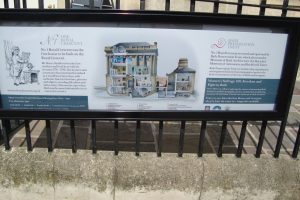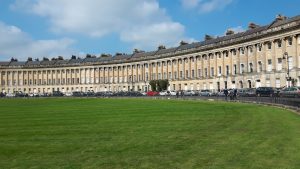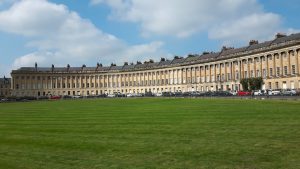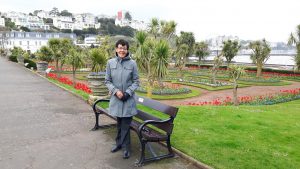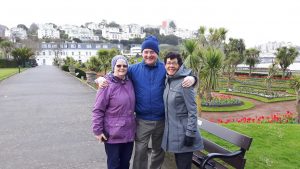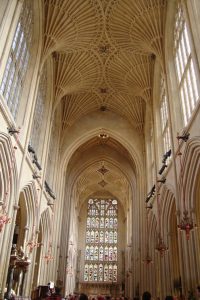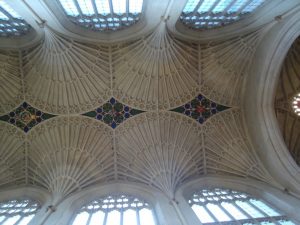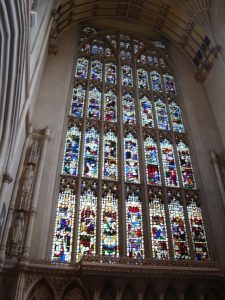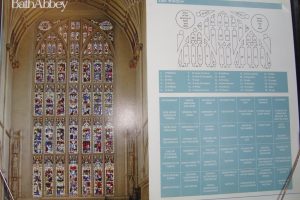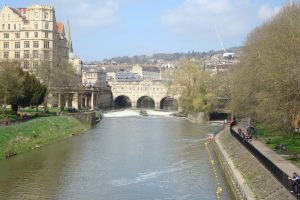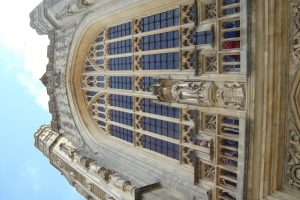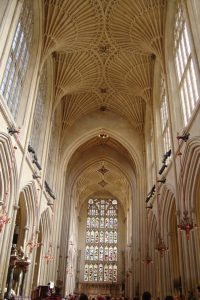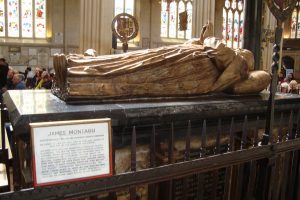Day 6
“Here they are,” I said. Pearl and I were watching out of her living room window as a red car pulled into the driveway. My friends, David and Hilary, came to the door, and Pearl invited them in. Introductions and a few pictures taken, hugs and goodbyes and we were on our way. Hilary insisted I sit in the front passenger seat. “It’s so long since you were in England, I want you to enjoy the scenery,” she said. And for the rest of our travels, she insisted the same. Such kindness.
Bath Abbey was on our itinerary, and Hilary, a great reader of maps, realized we might as well visit it on our way travelling south to Devon rather than backtrack later. We did stop on the way down and visited a garden centre and had a cup-of-tea. Then on to Bath in the county of Somerset! As David drove, I started humming a song to myself that we had learned in school. The author extolled the virtues of Somerset, and the many species of apples heaped in baskets gleaming row by row, and how he wished he was there because it was April, but instead, he was in overcrowded London. And he wrote about the robins singing in the rain. But there was no rain that day, by the time we got to Bath it was so hot, we left our coats in the car and walked across the Pulteney Bridge to the city centre. We entered the spacious courtyard of Bath Abbey, where people sat around the periphery on benches enjoying the sunshine. A young musician played classical music on a violin.
Although we did not visit the Roman Baths, I would be amiss if I did not mention that they are situated right next to the Abbey. We could see the back of the statue of a Roman centurion. The Romans discovered the only hot springs in all of England and built the baths around them. Leaving their distinct genius in Bath.
We crossed the courtyard and entered the main entrance to the Abbey.
There is much to know about the Abbey, but briefly, it has been the site of Christian worship for over a thousand years as far back as Anglo-Saxon times.
‘After the dissolution of the monasteries in 1539 by order of King Henry VIII, the Abbey lay in ruins for more than 70 years. It wasn’t until 1616 that much of the building we see today was repaired and in use as a parish church and over two hundred years later, in the 1830s, that local architect George Manners added new pinnacles and flying buttresses to the exterior and inside, built a new organ on a screen over the crossing, more galleries over the choir and installed extra seating.’ Source: http://www.bathabbey.org/history
We entered the sanctuary, or more correctly, the nave, and saw a group of sixty to seventy smartly dressed men grouping together in the quire. Yes, the quire dear reader, but to us that area beyond the nave. Tourists sat in the pews waiting. Soon the voices of the men soared in harmony with beautiful renditions, of How Great Thou Art, When the Saints go Marching in, Amazing Grace, and other hymns of praise.
Hilary and I, along with other folks, walked around reading the many wall plaques which gave brief histories of people who had contributed to the Abbey, or wealthy families who could afford a plaque. It was poignant to see that many died in their late teens-early twenties. Obviously, the lack of medical knowledge was the cause.
We gazed at some of the stained-glass windows depicting bible stories.
The windows take up 80% of the wall space. We browsed the gift shop and bought a few items.
Of note, too, is the fact that Jane Austen was a resident of Bath. In the fall there is a Jane Austen Festival. You know, Pride and Prejudice, and Mr. Darcy…sigh!
It was lunchtime. Off we went to Marks and Spencer’s to purchase pre-packed sandwiches. We sat on a bench and ate! Before I could swallow my first mouthful, David snapped a picture of us, me with a mouthful of a chicken salad sandwich, and Hilary smiling nicely! After lunch, we drove to the Royal Crescent.
The Royal Crescent, one of Bath’s most iconic landmarks, was built between 1767 and 1775 and designed by John Wood the Younger.
This impressive landmark is arranged around a perfect lawn overlooking Royal Victoria Park and forms a sweeping crescent of 30 Grade I Listed terrace houses. It is without doubt one of the greatest examples of Georgian architecture anywhere in the UK.
The 500-foot-long crescent has an impressive ha-ha, (plot) which was designed to keep grazing animals out of the more formal areas of the garden. Many notable people have either lived or stayed in the Royal Crescent since it was built, and some are commemorated on special plaques attached to the relevant buildings. Source: Bath Website UK
It was a warm day, and most pleasant. We lingered there, along with tourists and locals. Looking across the green, we watched children playing, dogs running, and people strolling.
But eventually, it was time to move on, and we proceeded to Torquay. Daffodils and primroses still graced the hedgerows and gardens. The closer to the south, we drew the more gorse bushes we saw, their vibrant yellow flowers beckoning us on, but wait! Mist! A sea mist creeping up over the hills ahead of us. Hmm, I remember the sea mists. John Masefield’s poem Sea Fever popped into my mind.
I must go down to the seas again, to the lonely sea and the sky,
And all I ask is a tall ship and a star to steer her by,
And the wheel’s kick and the wind’s song and the white sail’s shaking,
And a grey mist on the sea’s face, and a gray dawn breaking.
I must go down to the seas again, for the call of the running tide
Is a wild call and a clear call that may not be denied;
And all I ask is a windy day with the white clouds flying,
And the flung spray and the blown spume, and the seagulls crying.
I must go down to the seas again, to the vagrant gypsy life,
To the gull’s way and the whale’s way where the wind’s like a whetted knife;
And all I ask is a merry yarn from a laughing fellow-rover
And quiet sleep and a sweet dream when the long trick’s over.
I suppose he longed for that aloneness when he wrote it. Just him, the ship, and the sea. That’s the way it is with fishermen too. I recalled them in my childhood, down on the quay calling out to each other, sorting out their catch, and the seagulls soaring above crying out for a morsel.
On we went, and soon enough we were in Torquay. Signs in cheerful lettering read, ‘Welcome to the English Riviera,’ and palm trees swayed this way and that as if waving us on along toward the seafront. The sea on our right, and a cluster of houses and hotels, up in the hills, to our left. Then came Torre Abbey Gardens, the flower beds filled with red tulips, wallflowers, pansies, and lobelia. A splendid array of colour. Hilary saw it first-our hotel, and soon we were registered and meeting in the restaurant for dinner.

